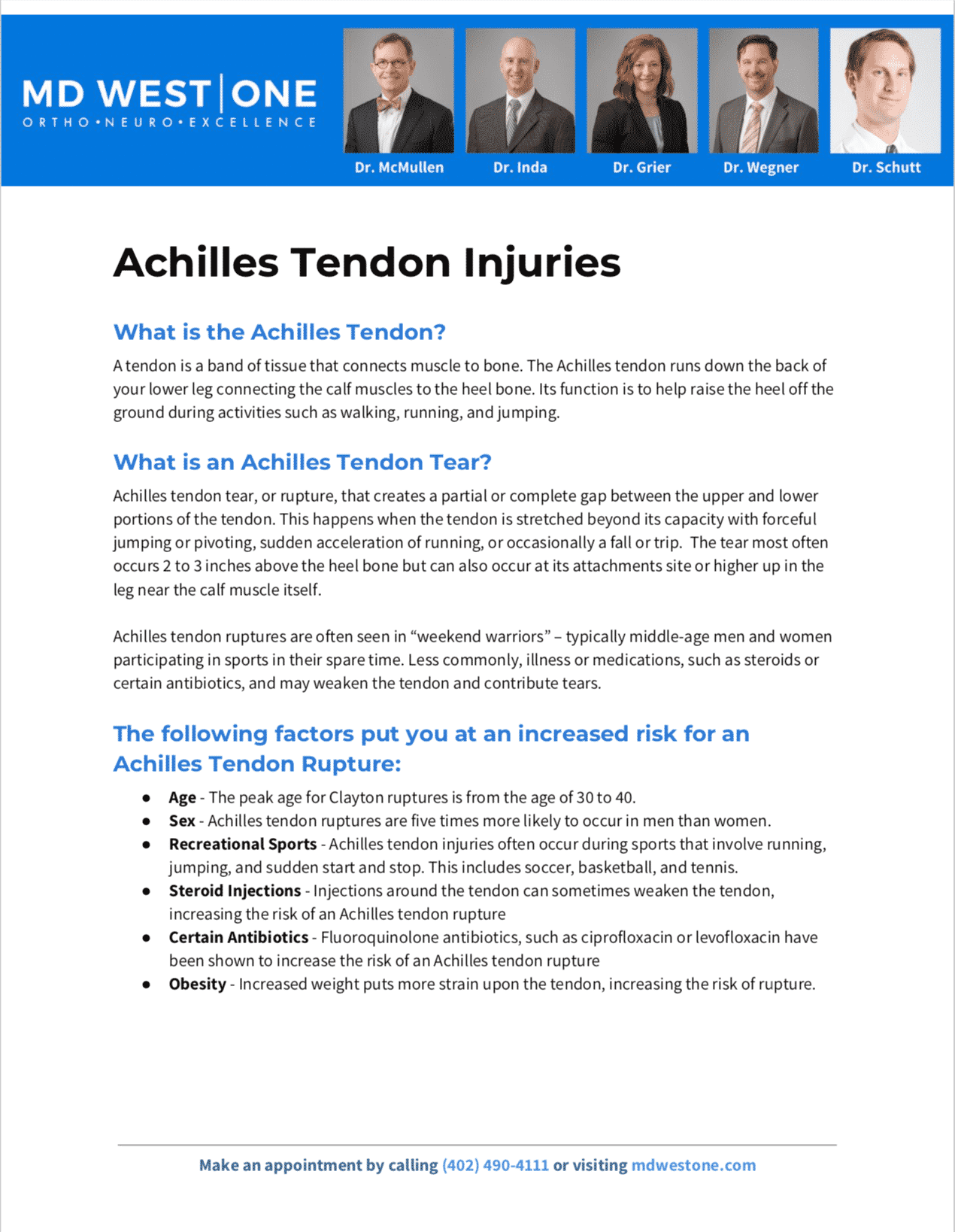Are you suffering from potential Flat Foot?
The Omaha Foot & Ankle Specialists at MD West ONE are able to properly diagnose and treat flat foot through both surgical and non-surgical treatments. If you have the following symptoms, you may want to make an appointment with one of our Board Certified Specialists.
Many people with flat feet do not experience pain or other problems. But certain types of flat foot can be painful. Symptoms may include:
- Leg cramps
- Muscle pain (aching or fatigue) in the foot or leg
- Pain in the arch, ankle, heel, or outside of the foot
- Pain when walking or changes in your gait (how you walk)
- Toe drift (front part of the foot and toes point outward)
Meet MD West ONE's foot and ankle specialists and learn more about how they treat flat foot.
Flat Foot Causes, Treatments & Surgery
What is Flat Foot?
All babies have flat feet at birth. Arches typically form by age 6. About two out of 10 children still have flat feet as adults. Some adults have arches that collapse. This condition, fallen arches, is another term for flat foot.
Flat feet are not a problem for most people. If flat feet cause pain or other problems, treatments can help.
The following factors put you at an increased risk for an Achilles Tendon Rupture:
-
Achille's tendon injuries
-
Broken bones
-
Cerebral palsy
-
Diabetes
-
Down syndrome
-
High blood pressure
-
Obesity
-
Pregnancy
-
Rheumatoid arthritis
Ways to Decrease Your Risk of Developing Flat Foot Problems:
- Often, there is not anything you can do to prevent flat feet. Staying at a healthy weight may ease pain from flat feet.
DIAGNOSIS
Your healthcare provider can make a dianosis by assessing symptoms and evaluating how your arches look when you stand, sit, and walk. You may get X-rays to look at bone structure.
TREATMENT OPTIONS
Many people with flat feet do not have significant problems or need treatment. Your healthcare provider may recommend nonsurgical treatments if you experience foot pain, stiffness, or other issues. Rarely, people need surgery to fix rigid flat feet or problems with bones or tendons.
Treatments include:
- Nonsteroidal anti-inflammatory drugs (NSAIDs), rest and ice to ease inflammation and pain.
- Physical therapies to stretch and strengthen tight tendons and muscles, improving flexibility and mobility.
- Supportive devices like foot orthotics, foot, or leg braces and custom-made shoes.
Frequently Asked Questions?
What is the prognosis (outlook) for people who have flat feet?
Most people with flat feet get symptom relief with nonsurgical treatments. Some people do not need any treatment. Flat feet may increase your risk of certain problems like:
- Arthritis
- Bone spurs
- Bunions or corns and calluses
- Lower back pain, hip pain, or knee pain
- Shin splints
You should call your healthcare provider if you experience:
- Balance problems.
- Difficulty walking, including pain when walking.
- Stiff, painful feet.
- Sudden development of flat feet (fallen arches).
What questions should I ask my doctor?
- What caused my flat feet?
- What is the best treatment for my flat feet?
- Am I at risk for other problems?
- Should I look out for signs of complications?
AMERICAN ORTHOPAEDIC FOOT & ANKLE SOCIETY
All of the foot and ankle surgeons in the practice are recognized members of the American Orthopaedic Foot & Ankle Society. It is the oldest and most prestigious medical society dedicated to the foot and ankle. The mission of the society is to advance science and practice of foot and ankle surgery through education, research, and advocacy on behalf of patients and practitioners. These physicians dedicate their time and energy to improving the patient experience and their knowledge in their field. For more information visit http://www.aofas.org.
MD West ONE Foot & Ankle Specialists:
The Foot & Ankle Specialists are all Board Certified and Fellowship-Trained, meaning they’ve focused their education, training and research on orthopaedic surgery of the foot and ankle.





